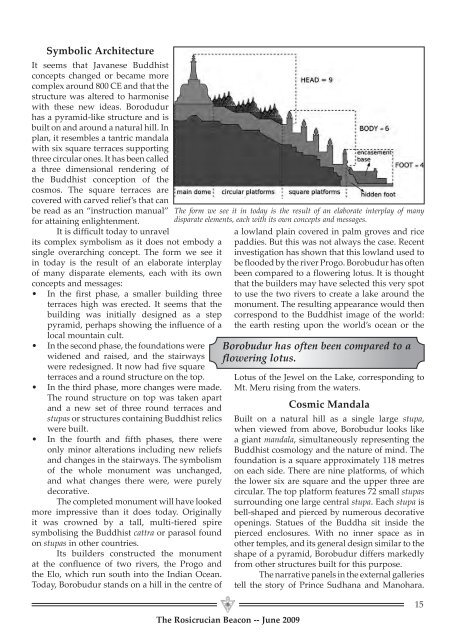RosicRucian - AMORC
RosicRucian - AMORC
RosicRucian - AMORC
- No tags were found...
Create successful ePaper yourself
Turn your PDF publications into a flip-book with our unique Google optimized e-Paper software.
Symbolic ArchitectureIt seems that Javanese Buddhistconcepts changed or became morecomplex around 800 CE and that thestructure was altered to harmonisewith these new ideas. Borodudurhas a pyramid-like structure and isbuilt on and around a natural hill. Inplan, it resembles a tantric mandalawith six square terraces supportingthree circular ones. It has been calleda three dimensional rendering ofthe Buddhist conception of thecosmos. The square terraces arecovered with carved relief’s that canbe read as an “instruction manual”for attaining enlightenment.It is difficult today to unravelits complex symbolism as it does not embody asingle overarching concept. The form we see itin today is the result of an elaborate interplayof many disparate elements, each with its ownconcepts and messages:• In the first phase, a smaller building threeterraces high was erected. It seems that thebuilding was initially designed as a steppyramid, perhaps showing the influence of alocal mountain cult.• In the second phase, the foundations werewidened and raised, and the stairwayswere redesigned. It now had five squareterraces and a round structure on the top.• In the third phase, more changes were made.The round structure on top was taken apartand a new set of three round terraces andstupas or structures containing Buddhist relicswere built.• In the fourth and fifth phases, there wereonly minor alterations including new reliefsand changes in the stairways. The symbolismof the whole monument was unchanged,and what changes there were, were purelydecorative.The completed monument will have lookedmore impressive than it does today. Originallyit was crowned by a tall, multi-tiered spiresymbolising the Buddhist cattra or parasol foundon stupas in other countries.Its builders constructed the monumentat the confluence of two rivers, the Progo andthe Elo, which run south into the Indian Ocean.Today, Borobudur stands on a hill in the centre ofThe form we see it in today is the result of an elaborate interplay of manydisparate elements, each with its own concepts and messages.a lowland plain covered in palm groves and ricepaddies. But this was not always the case. Recentinvestigation has shown that this lowland used tobe flooded by the river Progo. Borobudur has oftenbeen compared to a flowering lotus. It is thoughtthat the builders may have selected this very spotto use the two rivers to create a lake around themonument. The resulting appearance would thencorrespond to the Buddhist image of the world:the earth resting upon the world’s ocean or theBorobudur has often been compared to aflowering lotus.Lotus of the Jewel on the Lake, corresponding toMt. Meru rising from the waters.Cosmic MandalaBuilt on a natural hill as a single large stupa,when viewed from above, Borobudur looks likea giant mandala, simultaneously representing theBuddhist cosmology and the nature of mind. Thefoundation is a square approximately 118 metreson each side. There are nine platforms, of whichthe lower six are square and the upper three arecircular. The top platform features 72 small stupassurrounding one large central stupa. Each stupa isbell-shaped and pierced by numerous decorativeopenings. Statues of the Buddha sit inside thepierced enclosures. With no inner space as inother temples, and its general design similar to theshape of a pyramid, Borobudur differs markedlyfrom other structures built for this purpose.The narrative panels in the external galleriestell the story of Prince Sudhana and Manohara.The Rosicrucian Beacon -- June 200915











